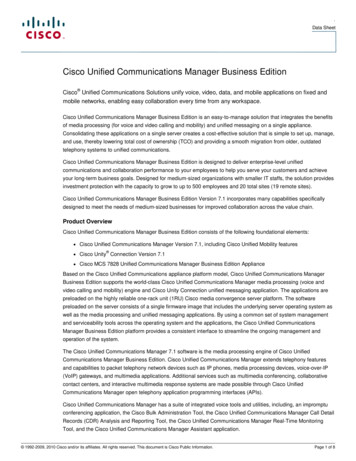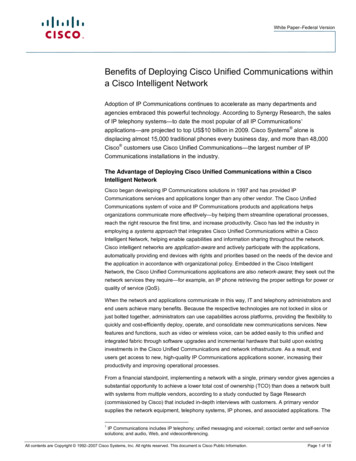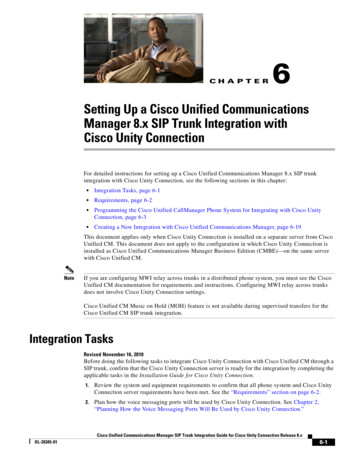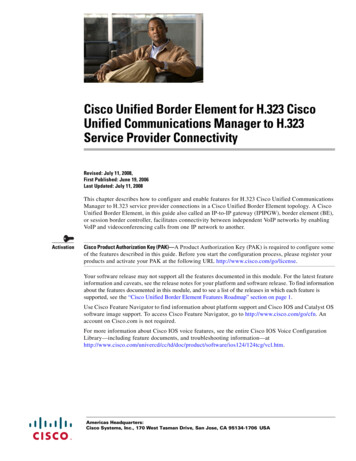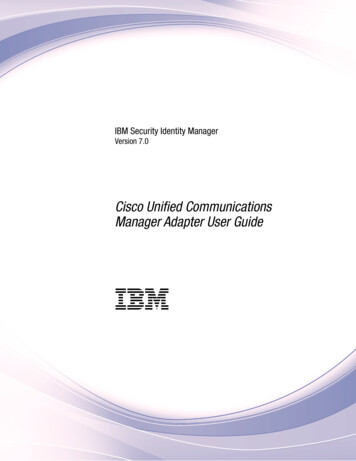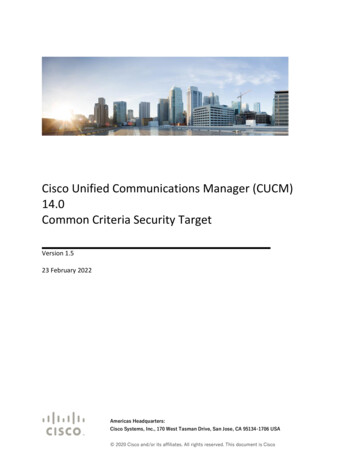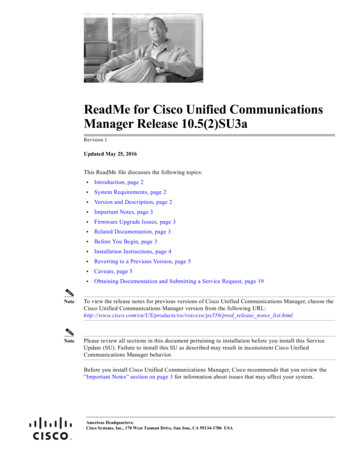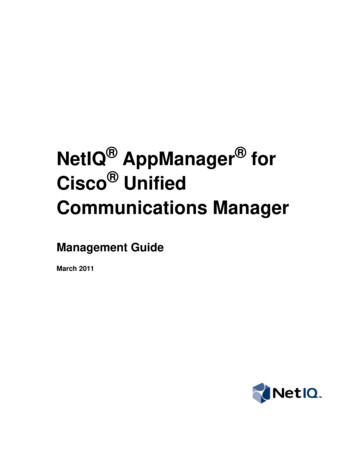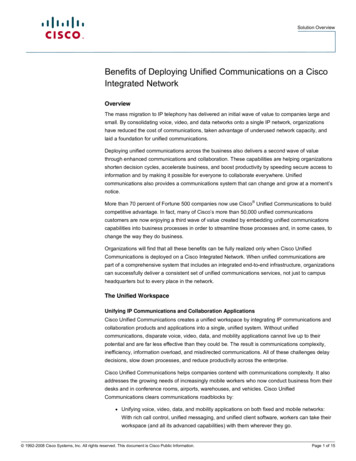
Transcription
Solution OverviewBenefits of Deploying Unified Communications on a CiscoIntegrated NetworkOverviewThe mass migration to IP telephony has delivered an initial wave of value to companies large andsmall. By consolidating voice, video, and data networks onto a single IP network, organizationshave reduced the cost of communications, taken advantage of underused network capacity, andlaid a foundation for unified communications.Deploying unified communications across the business also delivers a second wave of valuethrough enhanced communications and collaboration. These capabilities are helping organizationsshorten decision cycles, accelerate business, and boost productivity by speeding secure access toinformation and by making it possible for everyone to collaborate everywhere. Unifiedcommunications also provides a communications system that can change and grow at a moment’snotice.More than 70 percent of Fortune 500 companies now use Cisco Unified Communications to buildcompetitive advantage. In fact, many of Cisco’s more than 50,000 unified communicationscustomers are now enjoying a third wave of value created by embedding unified communicationscapabilities into business processes in order to streamline those processes and, in some cases, tochange the way they do business.Organizations will find that all these benefits can be fully realized only when Cisco UnifiedCommunications is deployed on a Cisco Integrated Network. When unified communications arepart of a comprehensive system that includes an integrated end-to-end infrastructure, organizationscan successfully deliver a consistent set of unified communications services, not just to campusheadquarters but to every place in the network.The Unified WorkspaceUnifying IP Communications and Collaboration ApplicationsCisco Unified Communications creates a unified workspace by integrating IP communications andcollaboration products and applications into a single, unified system. Without unifiedcommunications, disparate voice, video, data, and mobility applications cannot live up to theirpotential and are far less effective than they could be. The result is communications complexity,inefficiency, information overload, and misdirected communications. All of these challenges delaydecisions, slow down processes, and reduce productivity across the enterprise.Cisco Unified Communications helps companies contend with communications complexity. It alsoaddresses the growing needs of increasingly mobile workers who now conduct business from theirdesks and in conference rooms, airports, warehouses, and vehicles. Cisco UnifiedCommunications clears communications roadblocks by: Unifying voice, video, data, and mobility applications on both fixed and mobile networks:With rich call control, unified messaging, and unified client software, workers can take theirworkspace (and all its advanced capabilities) with them wherever they go. 1992-2008 Cisco Systems, Inc. All rights reserved. This document is Cisco Public Information.Page 1 of 15
Solution Overview Enabling more effective communications: With presence and instant messaging, people cancheck the availability of colleagues, know how and where co-workers wish to be reached,and click-to-communicate in real time. Delivering media-rich collaboration: When voice, video, and web conferencing solutions usethe power of the integrated network, people can collaborate instantly. They can also easilyescalate sessions by adding video to an audio conversation or by adding web conferencingor whiteboarding to an existing audio or video conversation. Enabling the creation of business applications: With Cisco service creation platforms,customers and partners can develop innovative rich-media and web applications, making itpossible to embed unified communications capabilities into existing business processsystems.The Power of an Integrated NetworkAn End-to-End SystemCisco provides an end-to-end unified communications system that uses the pervasive reach of anintegrated network to enable the unified workspace. The secure network foundation includesindustry-leading routers and switches that exhibit three types of intelligence: Device-aware: Because Cisco integrates intelligence throughout the network — even in theendpoints — a Cisco Integrated Network “knows” which device is being used, where it isbeing used, and what unified communications applications it is allowed to use. Application-aware: A Cisco Integrated Network actively participates with applications,automatically providing the appropriate rights, priorities, and organizational policies of eachapplication. Network-aware: Cisco Unified Communications applications seek out the network servicesthey require to help ensure that applications receive the appropriate quality of service(QoS).When the network and applications interact this way, IT administrators and end users enjoy manybenefits. Because the technologies are not bolted together, administrators can use capabilitiesacross platforms, providing the flexibility to quickly and cost-efficiently deploy, operate, andconsolidate new communication services. You can add features such as video or wireless voicethrough software upgrades and incremental hardware that builds upon existing networkinfrastructure. As a result, you have access to new business applications sooner, increasing theirproductivity and improving business processes.Lower Total Cost of OwnershipIn addition to these advanced capabilities, by implementing a Cisco Integrated Network (versus anetwork built with systems from multiple vendors) your organization can also enjoy a lower totalcost of ownership (TCO): The networking costs per employee are, on average, almost 50 percent lower: According toa report by IDC (Operational Excellence in Networking: Industry Leaders Point the Way,IDC, April 2007), companies that consolidate router, switch, security, wireless, and voicevendors have, on average, a 45.6-percent lower cost per employee than those with six ormore vendors. 1992-2008 Cisco Systems, Inc. All rights reserved. This document is Cisco Public Information.Page 2 of 15
Solution Overview Each endpoint has a lower cost of ownership: According to a customer study conducted bySage Research (Unified Communication Application: Uses and Benefits, Sage /collateral/ns340/ns394/ns165/net implementation white paper0900aecd8040970b.pdf), organizations that use a single, primary network vendorhave on average a 26-percent lower cost of ownership per endpoint than those that usemultiple vendors. The overall network cost of ownership is substantially lower: Sage Research also found thatorganizations that use a single vendor for IP telephony have a 43-percent lower networkcost of ownership than those that use multiple vendors. These savings are derived from allareas, including network deployment and maintenance, network performanceimprovements, and benefits for both IT and end users.Cisco offers validated designs and industry best practices that are required in order for the networkto deliver these benefits in deployment, operational manageability, and consolidation. Theserecommendations are based on the type of business site or its place in the enterprise network.Recommendations for a Head Office or CampusTypically, the primary users of business-critical and rich-media applications are the employees inthe campus or head office. The campus infrastructure is built around a high-speed LAN switchingnetwork. A Cisco Integrated Network delivers the following unified communications benefits in thecampus environment.Faster, More Cost-Effective DeploymentsIn large companies, approximately 25 percent of personnel move each year. The Yankee Groupestimates that it costs companies up to US 150 per move, add, or change. You can significantlyminimize this enormous expense with Cisco Unified Communications products and Cisco Catalyst switching solutions in a Cisco Integrated Network: When a Cisco Unified IP Phone is plugged into a wall jack, the Cisco Catalyst switchautomatically detects the phone and extracts the device information through either LinkLayer Discovery Protocol-Media Endpoint Devices (LLDP-MED) or Cisco Discovery Protocolexchange. Then, using the Cisco Embedded Event Manager (EEM) feature in the Cisco Catalystswitch, you can automatically configure the switchport for voice. Cisco EEM is a powerfuland flexible automation technology. It reduces deployment costs by allowing administratorsto set policies that control the actions that a switch should dynamically take when specificevents occur. For administrators who use Cisco Network Assistant, Cisco offers an alternate method forconfiguring switches for voice. When a Cisco Unified IP Phone is plugged in, the SmartportsAdvisor feature on the Cisco Catalyst switch can automatically send a dialogue box promptto the Cisco Network Assistant management interface. The administrator can then apply theappropriate Smartports Advisor voice macros to that switchport for easy configuration. If you need to move to a new location, you simply unplug your phone and plug it into thewall jacks in your new office. Removing the voice configuration on the previous switchporthelps to strengthen security. You can remove the configuration dynamically when the phoneis unplugged. 1992-2008 Cisco Systems, Inc. All rights reserved. This document is Cisco Public Information.Page 3 of 15
Solution OverviewOther vendors that partner with infrastructure vendors or offer only voice components lack this typeof integration. As a result, each time an IP phone is moved or added to the network, IT personnelmust manually reconfigure the switchports, significantly increasing administrative and supportcosts, especially in large enterprises with tens of thousands of IP phones.Nonstop Communications over the LANIP-based voice networks must deliver the same continuously available service that was providedwith traditional time-division multiplexing (TDM) voice networks. High availability starts with ahierarchical network design (Figure 1) that allows for separation of core, distribution, and accesslayers as well as the fault domains within these layers.Figure 1.Recommended Network Topology for Highly Available Campus NetworkCisco recommends the following guidelines for building access, distribution, and core layers in thecampus. Maintain triangle topologies for Layer 3 routing peers, especially between the core anddistribution switches: This topology helps ensure that a switch can take two equal paths toget to a destination. These two paths will simultaneously reside in the routing table. If a linkfailure occurs, the traffic will flow on the other path without requiring a route recalculation. Summarize routes from the distribution to the core: This process prevents the core switchesfrom having to respond to routing advertisements coming from the access and distributionlayers. Deploy switches with high-availability innovations: Cisco Catalyst 6500, Catalyst 4500, andCatalyst 3750-E switches lead the industry in meeting uptime requirements with advancedtechnology that contains, detects, and resolves faults faster with minimal effect on voicetraffic. Features such as Stateful Switchover (SSO) preserve critical state information acrossdual supervisor engines to help ensure that unified communications traffic is continuallyswitched if a primary supervisor engine fails. Cisco IOS Software Modularity allows you toupgrade single software modules without having to take the switch out of service, therebyincreasing up-time even for planned upgrades. This feature localizes the effect of softwareprocess faults with a protected memory architecture. Even if a software process failureoccurs, voice and video traffic can continue.For more best practices for designing a multilayer network, refer to the Campus Network for HighAvailability Design Guide ing solutions design guidances list.html. 1992-2008 Cisco Systems, Inc. All rights reserved. This document is Cisco Public Information.Page 4 of 15
Solution OverviewQuality of ServiceUnified communications requires new IP endpoints that deliver rich media to campus constituents.To ensure QoS, all forms of traffic — voice, video, and data — are assigned the appropriate classof service (CoS). CoS and Priority Queuing are controlled by Cisco Catalyst switches. Maintaining voice quality through the switch: The CoS value for unified communicationsvoice traffic is controlled by the Cisco Catalyst switch. The switch indicates to the CiscoUnified IP Phone which voice VLAN ID it should use and then automatically applies theappropriate CoS value. The switch can also indicate CoS for traffic coming from devicesattached to the phone using the Extended Trust feature. A CoS value of 5 indicates highpriority and is usually reserved for voice. Call signaling is given a value of 3, and best-efforttraffic is given a value of 0. So even if a rogue PC tries to raise its CoS value to 5, the CiscoUnified IP Phone resets the CoS value on the incoming packets of that PC to the CoS valueindicated by the switch. Monitoring traffic to ensure QoS: Voice traffic is typically assigned the highest-priorityqueue. You can set an EEM script on a Cisco Catalyst 6500 Switch to detect excessivepacket drops and automatically alert the network administrator. Additional voice trafficmonitoring and troubleshooting capabilities are provided through the network analysismodule (NAM), a data, voice, and video traffic-analysis blade. For example, if dial tone orcall setup latency exceeds specified thresholds, the NAM detects these anomalies, analyzesCisco Unified Communications Manager response times, and then sends an alert to anetwork operator. For H.323, Media Gateway Control Protocol (MGCP), Skinny ClientControl Protocol (SCCP), and Session Initiation Protocol (SIP) traffic, the NAM monitorsactive calls between caller and callee pairs and identifies call quality degradation byreporting packet loss and jitter statistics. The NAM also performs Differentiated Services(DiffServ) QoS monitoring and provides traffic usage information for each DiffServ codepoint, helping validate QoS planning assumptions and detect unauthorized or incorrectlymarked traffic that could adversely affect voice QoS.Operational ManageabilityMost networking surveys show that operational costs far outweigh the initial purchase cost of theequipment. Cisco is constantly improving the ways to deploy and manage unified communicationson an end-to-end Cisco infrastructure. The following technologies help our customers optimize andefficiently operate this integrated network: Smartports macros: Based on Cisco best practices, Smartports macros can be applied toany Cisco Catalyst switch to make port configuration much simpler and more accurate. Witha standard or customized Cisco Smartports macro, an administrator no longer has to loginto each switchport and configure all the parameters for voice VLANs, port security,Dynamic Host Configuration Protocol (DHCP) snooping, and Spanning Tree PortFast.Instead, the administrator automatically uploads the Smartports macros, which include allthe proper settings. Cisco Smartports macros do not function in third-party or multivendornetwork environments. As you might imagine, the loss of this powerful cost-and-time-savingtool really accumulates when it comes to the moves, adds, and changes that generatesignificant costs each year. Cisco Smartports make these configuration changes as easy aspossible, providing a greater return on investment. AutoQoS macros: Cisco developed AutoQoS macros in response to customer demand for afaster way to deploy QoS configurations, which are traditionally deployed manually onhundreds or thousands of switch and router ports. This powerful feature of Cisco IOS 1992-2008 Cisco Systems, Inc. All rights reserved. This document is Cisco Public Information.Page 5 of 15
Solution OverviewSoftware automatically handles a range of tasks, including classifying applications,generating policies, configuring QoS, monitoring and reporting to test QoS effectiveness,and enforcing service-level consistency. After Cisco AutoQoS evaluates a networkenvironment and determines policy, it configures the port on an access switch to prioritizevoice traffic — with only one command. And it still offers the flexibility to adjust and tailorQoS settings to customer-specific requirements. It also automatically monitors QoS settingsand makes this information available in reports, with notification of abnormal events. Cisco IOS IP service-level agreements (SLAs): This tool actively monitors the health of theunderlying network by generating and then analyzing traffic between multiple networklocations or across multiple network paths. It uses the timestamp information to calculateperformance metrics such as jitter, latency, network and server response times, packet loss,and mean-opinion-score (MOS) voice-quality scores. Administrators can schedule a CiscoIOS IP SLAs operation at any point in time or continuously over any time interval. Cisco IOSIP SLAs is configured to monitor per-class traffic over the same link by setting the DiffServcode point (DSCP) bits. Administrators can specify measurement characteristics includingpacket size, packet spacing, protocol type, DSCP marking, and other parameters. They canuse measurement statistics provided by Cisco IOS IP SLAs operations for troubleshooting,problem analysis, and designing network topologies (Figure 2). Cisco IOS IP SLAs Responder: This component is embedded in the destination Ciscorouting device. It processes measurement statistics and sends detailed timestampinformation about the processing delay of the destination router back to the source Ciscorouter. Cisco recommends that round-trip delay be less than 150 ms and jitter be less than30 ms for successful transmission of voice traffic. Unidirection measurements are alsopossible.Figure 2.How It Works — Cisco IOS IP SLAs OperationsSecure CommunicationsThe increasing number of applications and devices available on the network introduces many newpoints of vulnerability. As a result, you can no longer deploy security as a mix of “point-product”solutions. Instead, network security must be pervasive, securing everything from endpoints such as 1992-2008 Cisco Systems, Inc. All rights reserved. This document is Cisco Public Information.Page 6 of 15
Solution OverviewIP phones and PCs to the software and devices in the network infrastructure itself. Unlike somevendors, which focus only on securing the voice components or the infrastructure itself, Cisco takesa systems-level approach that integrates security throughout the network. This integration includesfeatures and capabilities in the transport network, the endpoints, the call-processing infrastructure,and the applications.When you deploy Cisco Unified Communications applications on a Cisco Integrated Network, youdo not have to implement separate security devices. Cisco integrates critical security componentsdeep into the network. Cisco is the only vendor that provides this in-depth security control,delivering the following security components: Secure connectivity: Cisco offers many options that help ensure secure communications.For example, VLAN segmentation keeps voice traffic on separate virtual network segments.Voice and Video Enabled VPN (V3PN) provides secure remote connectivity. WLANs areprotected through Wi-Fi Protected Access (WPA) and WPA2. Call management andendpoints offer strong voice media encryption using the Secure Real-Time TransportProtocol (SRTP), and Transport Layer Security (TLS) provides protection for signalingtraffic. At the application layer, Cisco uses HTTPS to permit protected remote managementof IP communications applications. And the Cisco Unity system is the first voice messagingsystem to offer encrypted messaging. Trust and identity: To contextually identify users and establish trust, many standards-basedauthentication mechanisms must work together. Cisco offers support for traditionalauthentication, authorization, and accounting (AAA) services in the infrastructure, as well asmore advanced capabilities elsewhere with such tools as Extensible Authentication Protocol(EAP) and digital certificates. Wireless LANs (WLANs) can allow IP phones to transparentlyconnect on ports where user authentication with 802.1x is mandated. By deploying CiscoNetwork Admission Control (NAC) framework, customers can restrict non-security-compliantwired and wireless endpoints that may be vulnerable or infected with worms, viruses, orspyware. All these threats are stopped before they can enter the network and potentiallydisrupt voice services. Threat defense: Cisco uses many techniques to provide protection against aggressivethreats. Integrated and standalone firewalls and intrusion detection systems protect theinfrastructure, the voice VLANs, and WLANs. A hardened OS and integrated host intrusionprevention solution called Cisco Security Agent protects the call-processing components. Toprotect endpoints against common Layer 2 exploits such as man-in-the-middle attacks,Cisco employs advanced dynamic Address Resolution Protocol (ARP) inspection protectionand other tools on its LAN switches and unified IP phones. In addition, the Cisco UnifiedCommunications applications themselves offer security features. For example, Cisco UnifiedCommunications Manager can support multiple levels of administration access andadvanced protection against toll fraud. Finally, the Cisco Integrated Network infrastructure isdesigned to withstand denial-of-service (DoS) attacks so that data and voice trafficcontinues to be forwarded even when DoS attacks occur. Cisco Catalyst 6500 and Catalyst4500 switches provide such protection through CPU rate limiters as well as control planepolicing (CoPP), which is embedded in the hardware.Scalable Wireless ServicesBusinesses today use wireless networking to give employees access to the business applicationsand communication tools they need even when they are on the move. By adding voice-over-IP(VoIP) capability to wireless networks, organizations can improve collaboration and responsiveness 1992-2008 Cisco Systems, Inc. All rights reserved. This document is Cisco Public Information.Page 7 of 15
Solution Overviewwhile realizing cost savings. The combination of Cisco Unified Communications and the CiscoUnified Wireless Network lets organizations provide IP communications for mobile workers whileminimizing TCO.Cisco integrates important technologies into its switching, routing, and wireless offerings to provideoptimal support for wireless voice, simplified wireless voice deployment and management, wirelessvoice call roaming, diverse wireless voice client support, and high-quality wireless voicecommunications. These technologies include: Simplified wireless voice deployment and management: Cisco integrates wireless controllerfunctions into its switches and routers so network managers can scale and manage wirelessnetworks as easily as they scale and manage traditional wired networks. For example, theCisco Catalyst 6500 Series/7600 Series Wireless Services Module (WiSM) supports zerotouch deployments that require no preconfiguration of access points. It also supports QoSpolicies, mobility groups, and back-end services, as well as other important tools such astemplate-based configuration management, which allows quick application of systemwidewireless security configurations.When deployed with the Cisco Wireless Control System (WCS), the Cisco Catalyst 6500WiSM supports enhanced monitoring and troubleshooting features such as intuitive heatmap displays, alarm filtering, event correlation, and granular reporting tools. This CiscoCatalyst module also supports the simultaneous tracking of 10,000 wireless client devicesfrom directly within the WLAN infrastructure when deployed with the Cisco WirelessLocation Appliance.The Cisco Catalyst 6500 WiSM facilitates maximum access point coverage — 300lightweight access points per module and clustering of up to 3600 lightweight access pointsper roaming domain. For remote-site deployments, Cisco also offers the Cisco Catalyst3750G-24WS Switch, which can manage up to 50 lightweight access points and the CiscoWireless LAN Controller Module (WLCM) for Cisco integrated services routers, which canmanage up to six lightweight access points. Standalone WLAN controllers such as the Cisco4400 and 2100 Series Wireless LAN Controllers are also available. Wireless voice call roaming: Efficient roaming is critical for voice applications, which areunforgiving of any delays in authentication. The Cisco Catalyst 6500 WiSM, the CiscoCatalyst 3750G-24WS, and the WLCM offer fast, secure roaming that facilitates roaming ofvoice clients between access points in the same subnet (Layer 2 roaming) or betweensubnets (Layer 3 roaming) without disruption to voice calls. Integration with diverse wireless clients: A growing number of client devices support 802.11wireless voice communications today, including dual-mode cell phones, personal digitalassistants (PDAs), laptop softphones, and Wi-Fi handsets such as the Cisco UnifiedWireless IP Phone 7920. Cisco Compatible Extensions, a licensing program for wirelessclients, facilitates secure interoperation of these devices with the Cisco Unified WirelessNetwork. It also helps enable interoperability of client-side features such as power-savemode, QoS, and assisted roaming. Wireless clients that support Cisco CompatibleExtensions undergo extensive testing at an independent third-party test lab to help ensuresupport for innovative Cisco features, as well as interoperability with the Cisco WLANinfrastructure. 1992-2008 Cisco Systems, Inc. All rights reserved. This document is Cisco Public Information.Page 8 of 15
Solution OverviewHigh-quality video over wireless: High-speed wireless access points that support the 802.11nstandard can deliver 248 Mbps of data. This level represents a significant increase over the 54Mbps delivered by 802.11g devices, and optimizes the delivery of voice and video. These newaccess points have higher power requirements, and Cisco Catalyst switches offer 20 watts ofenhanced Power over Ethernet (PoE) per port to support 802.11n access points without requiringadditional wiring or power outlets. In addition, Cisco wireless access points, client devices, andCisco Compatible Extensions devices include support for Wi-Fi Multimedia (WMM.) WMM is acomponent of the IEEE 802.11e WLAN standard that supports priority tagging and queuing toensure integrated handling of voice communications. Through the use of Layer 2 admission control,QoS can be maintained under heavy user loads to meet demanding wireless networking needs.Video as a Simple AdditionWhen Cisco Unified Communications is deployed on a Cisco Integrated Network, adding video tothe network is as easy as adding any other application because the applications and theinfrastructure are part of an intelligent system. This intelligence extends out to all types of devices(for example, laptops, PDAs, mobile phones, or remote PCs). If a device is video-enabled, therequired settings are generated automatically and the appropriate switches are instructed toprovide the proper VLAN and QoS to allow the video stream. Without intelligence distributedthroughout the network, video cannot be integrated as easily, proper settings require more manualeffort, and manageability is compromised.With an integrated network, organizations can: Enable video endpoints: You can introduce traditional video conferencing equipment basedon the H.323 video conferencing onto the converged network, and you can enable thesesystems to automatically register to Cisco Unified Communications Manager. Thereafter youcan easily control them with Cisco Unified Communications Manager. Optimize video delivery: IP Multicast is a bandwidth-conserving technology that reducestraffic by simultaneously delivering a single stream of information to multiple recipients. Thistechnology is ideal for video applications where the same large set of data or video must betransmitted efficiently to multiple clients. Dramatically simplify video conferencing management: Call detail records (CDRs) are alsointegrated into and managed by Cisco Unified Communications Manager. IT managers nolonger must download CDRs from two separate systems. Instead, all phone and videorecords are located in one place.Energy SavingsCisco Unified Communications on a Cisco Integrated Network can help reduce your company’scarbon footprint and conserve energy with a switching infrastructure that provides additional levelsof power control within each Cisco Catalyst switchport. Cisco Integrated Power Management (IPM)provides customers with significant power-consumption savings on devices (for example, IPphones, wireless access points, and IP video surveillance cameras) that use Cisco DiscoveryProtocol to negotiate power. Whereas the IEEE standard specifies that 802.3af power should beprovisioned in large increments of wattage such as 7 or 15 watts of power to each deviceregardless of power need, the Cisco IPM allows administrators to provision power based on thepower the device actually needs. For example, some Class 3 devices need only 10W instead of thedefault 15.4W value indicated in the 802.3af standard. This power optimization, combined with thescalable power supplies offered on modular Cisco Catalyst switches, helps customers: 1992-2008 Cisco Systems, Inc. All rights reserved. This document is Cisco Public Information.Page 9 of 15
Solution Overview Maximize PoE port density Minimize the number of switches required Expand savings through decreased use of electricity, backup UPS, and battery powersystemsVoice and Data Teams Share a Common View of the NetworkIn most enterprises, s
Unified Communications to build competitive advantage. In fact, many of Cisco's more than 50,000 unified communications customers are now enjoying a third wave of value created by embedding unified communications capabilities into business processes in order to streamline those processes and, in some cases, to change the way they do business.

